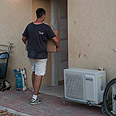
Caravilla dwellers waiting for fortification
Gush Katif evacuees, living in mobile homes, hope PM Netanyahu will keep his promise to build sheltered spaces in communities located up to 7 kilometers from Gaza Strip. 'We've heard countless promises, but in the meantime we're living in houses made of carton'
This time it was Prime Minister Benjamin Netanyahu, who vowed to fortify all communities located 4.5-7 kilometers (2.8-4.35 miles) from Gaza. Now all that is left is to find out whether it was just an election promise or a real change of policy.
Related stories:
- Netanyahu vows to complete fortification of south
- Southerner 'not angry at Gazans who shell Israel'
- South's communities try to resume normalcy
After dozens of rockets were fired at Israel from Gaza this week, Netanyahu faced television cameras and promised to fortify 1,620 houses, whose residents are constantly threatened by Palestinian terror organizations.
Some of the residents of Moshav Mavkiim in the Hof Ashkelon Regional Council are familiar with this routine. Up until 2005 they lived in communities within the Strip and defended the southern area with their own bodies, but danger has followed them to their new location as well.

Rami Yaakov near portable shelters (Photo: Avi Roccah)

Caravillas. Tremble from Iron Dome blasts (Photo: Ohad Zwigneberg)
"Bringing evacuees from Gush Katif and putting them in a carton box as a home is fine – they gave us a place to live. But we need fortification," says Rami Yaakov.
"I have been living here with my wife and two daughters, and we have heard countless promises. There is a huge gap between what we imagined and what is actually taking place."
The evacuees' situation is grim. They have been waiting for permanent homes for years, while living in a mobile home known as a "caravilla," which offers no protection against rockets.
"There are children here who have been traumatized for years," says Yaakov. "If the evacuation wasn't enough, now they have to deal with the threat of rockets without being able to secure. People here have no money to build their own home or protected space. They put concrete tubes outside our home, but it's impossible to reach them at night within 20 to 30 seconds."
A caravilla cannot prevent the entry of a Qassam or Grad rocket. "It's carton," says Yaakov. "Our entire house trembles even from the Iron Dome (rocket interception system) explosions.
"If a Qassam or Grad land here, these cartons will fall into pieces within seconds. Even if a rocket hits the road it will tear apart three or four houses. But when we have a protected space we'll be just a few steps away from fortification.
"It's possible that Netanyahu is compensating us for years of unfulfilled promises. We feel someone is thinking about us and that our children would live with anxiety. It's never too late. It's good that they reached this decision before human lives were lost."
Authorities responsible for construction
According to the plan, local authorities located up to 4.5 kilometers from the border will be in charge of building the protected spaces using funds received from the State. Once all plans are approved, it will take another eight months to start construction.
"I assume that adding a protected space will certainly be an improvement for our personal sense of security," says Shlomit of Mavkiim. "The veteran residents' houses aren't fortified either, and some of them are really old. My personal feeling is that a house made of concrete has an advantage over a house made of carton."

Rami Yaakov's house. Constant fear (Photo: Avi Roccah)
According to Shlomit, a permanent home is still a dream, but a protected space is a step in the right direction. "The economic situation here is not great, and apart from providing security, a fortified room is certainly an improvement we won't be able to obtain on our own," she says.
"Adding another room to a caravilla is not a trivial thing. A decision like the one made by the prime minister shows that someone is thinking about us, after we have been the country's backyard for such a long time."
Officials at the Hof Ashkelon Regional Council stress that fortifying caravillas is no different than fortifying a regular house. In most cases, all it entails is adding an external room which connects to the house through a sleeve. Regardless of the technology used to build the house, the cost and level of fortification are the same.
- Follow Ynetnews on Facebook and Twitter
- Receive Ynetnews updates directly to your desktop










